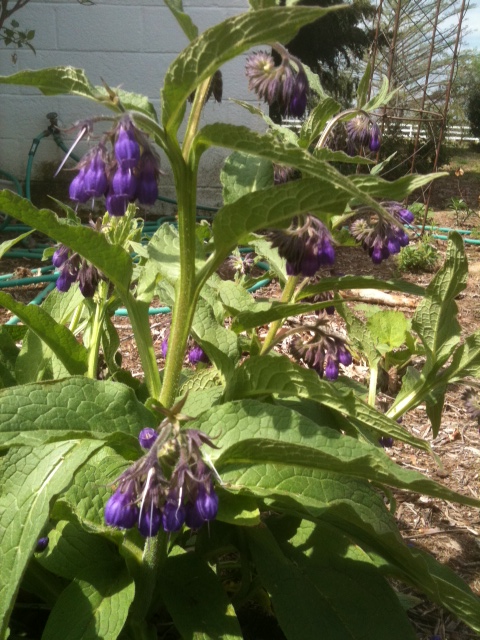Widely cultivated across Europe and Asia for centuries, common comfrey (symphytum officinale) is a humble plant with dramatic benefits. From soothing herbal remedies for skin irritations, bruises, and osteoarthritis to potent fertilizers, mulches, and foliar sprays, the easy-to-grow comfrey plant has a welcome place in any organic-based home garden.
Skin-Soothing, Regenerative, and Anti-Bacterial Properties
Comfrey contains high amounts of rosmarinic acid, tannins, and allantoin compounds that help to promote the growth of new cells, making this herb a the go-to topical for a variety of skin, muscle, bone, and joint issues.
1. Healing Bruises and Sores: If you have access to fresh leaves from the garden, a comfrey poultice is said to speed the healing of sore or bruised tissues and ligaments.
2. Soothing Skin Irritations: Salves, teas, oils and ointments are all popular treatments for a variety of irritant issues, including bug bites, sunburns, abrasive injuries, and certain rashes or over-dry patches of skin.
3. Antibacterial: Water-based applications like teas and simple compresses can deliver a potent antibacterial punch that can help to reduce the chance of infection and speed healing. Simply dampen a clean cloth with a strong comfrey extraction and apply directly to the affected area.
Benefits for Bone, Ligament and Joint Issues
4. Treating Sprains and Broken Bones: The concentrated allantoin in the leaves and roots of the plant can aid cellular regeneration and reduce inflammation in the case of pulled muscles, sprains, and broken bones.
5. Anti-Inflammatory: Recent clinical trials have shown evidence for the benefit of topical comfrey applications in treating a variety of joint and ligament issues, including back pain, osteoarthritis, and ankle sprains.
A Nutrient-Rich Companion for the Organic Garden
In addition to its many applications as a topical healer, comfrey makes a smart, sustainable addition to any gardening endeavor. A fast-growing perennial of the borage family, comfrey establishes deep roots that draw nutrients from deep within the soil. This unique property makes comfrey a natural ally for horticulturists looking to keep nutrient solutions completely organic and in-house!
6. A Soil-Mining Bioaccumulator: Like stinging nettles and daikon, the deep roots of comfrey are capable of mining nutrients and minerals that plants with more shallow root systems cannot reach. This makes their leaves a potent natural source of potassium, phosphorus, and nitrogen, as well as many valuable trace elements.
7. Rich Potting Soil: Due to the high nutrient content of its leaves comfrey is also useful for creating rich potting soils. To make a comfrey-based potting mixture, simply combine chopped leaves and dolomite in a tightly-lidded container for several months. Once fermented the mixture makes an excellent general potting soil, but keep in mind it will probably be too strong for seeds and seedlings!
8. High-Nitrogen Mulch: Freshly harvested comfrey leaves make an excellent mulch due to their impressive nitrogen content. Unlike mulches made from straw and leaves, which have high amounts of carbon, comfrey leaves will not pull nitrogen from the soil as they decompose. A high potassium content also makes comfrey-based mulches great for vegetables like peppers, tomatoes and cucumbers, as well as fruit trees and berries.
9. Soil Amendment: For a quick fertilizing fix, freshly cut comfrey leaves can be placed directly in planting holes; these large, moisture-rich leaves will break down rapidly, providing needed nutrients right at the roots of new plants.
10. Compost Activator: Adding comfrey leaves to your compost heap will give a nitrogen boost that can increase microbial decomposition – perfect for getting a slow-to-start compost pile heated up.
11. Liquid Fertilizer: Steeping and fermenting shredded comfrey leaves in water for several weeks in a sealed container produces a nutrient-rich fertilizing tea that can be used on garden or indoor plants.
12. Anti-Mildew Foliar Spray: Recent studies have shown that a comfrey tea foliar spray can be effective against fungal invasions of powdery mildew. Use a diluted tea or comfrey extract as a foliar drench or spray to help make precious plants more resistant to disease.
13. Soil Conditioner: With their deep and powerful taproots comfrey plants can not only mine deep sources of nutrients, they can also help to break up patches of dense, clay-packed earth. Comfrey’s extensive root systems provide natural soil aeration.
14. Slug and Snail Trap: Placing large comfrey leaves strategically around the garden can help to attract slugs and snails; wait over night and remove the leaves, slugs, snails and all the next morning.
15. Companion Plant: Comfrey makes an excellent, easy-growing companion plant for fruit, and especially apple orchards. Tall, fast growth and dense foliage prevent weeds from gaining a foothold.
Whether you are looking to make a potent organic fertilizer or add a versatile herb to your medicine chest, common comfrey has a lot to offer any home gardener.

